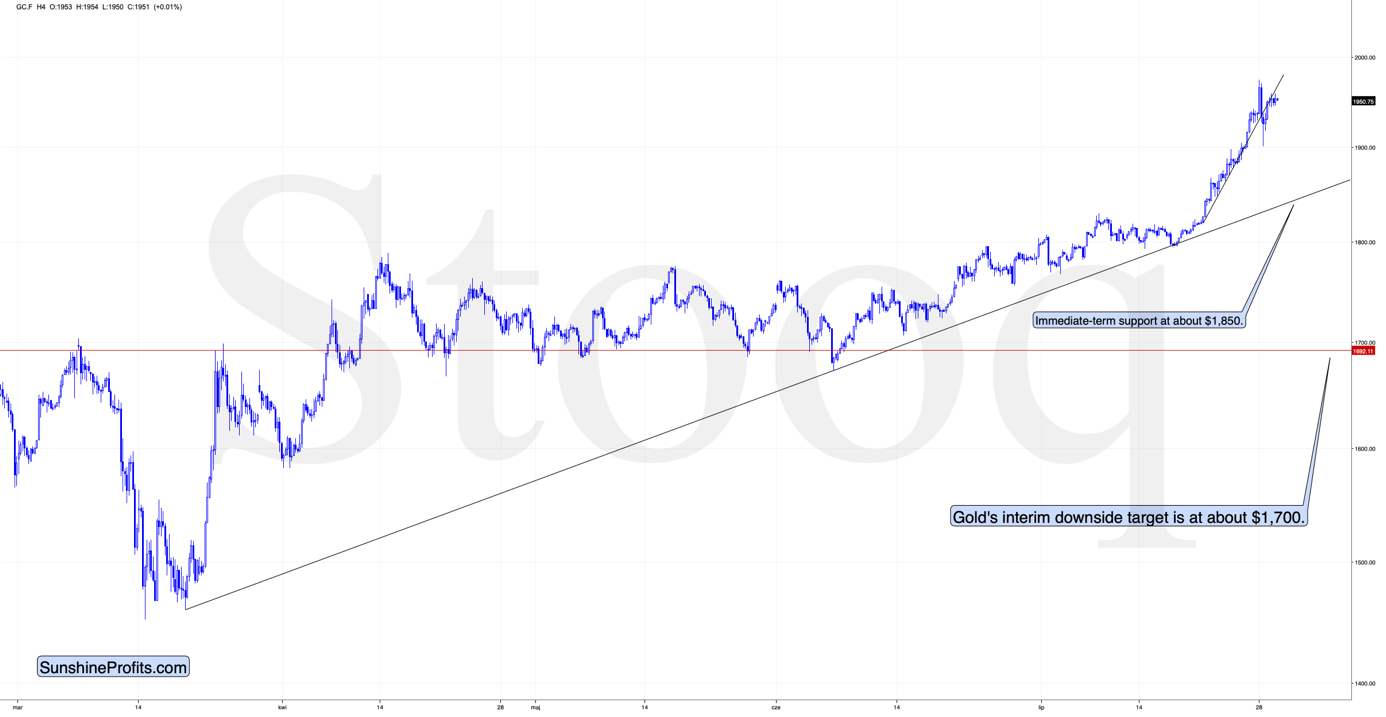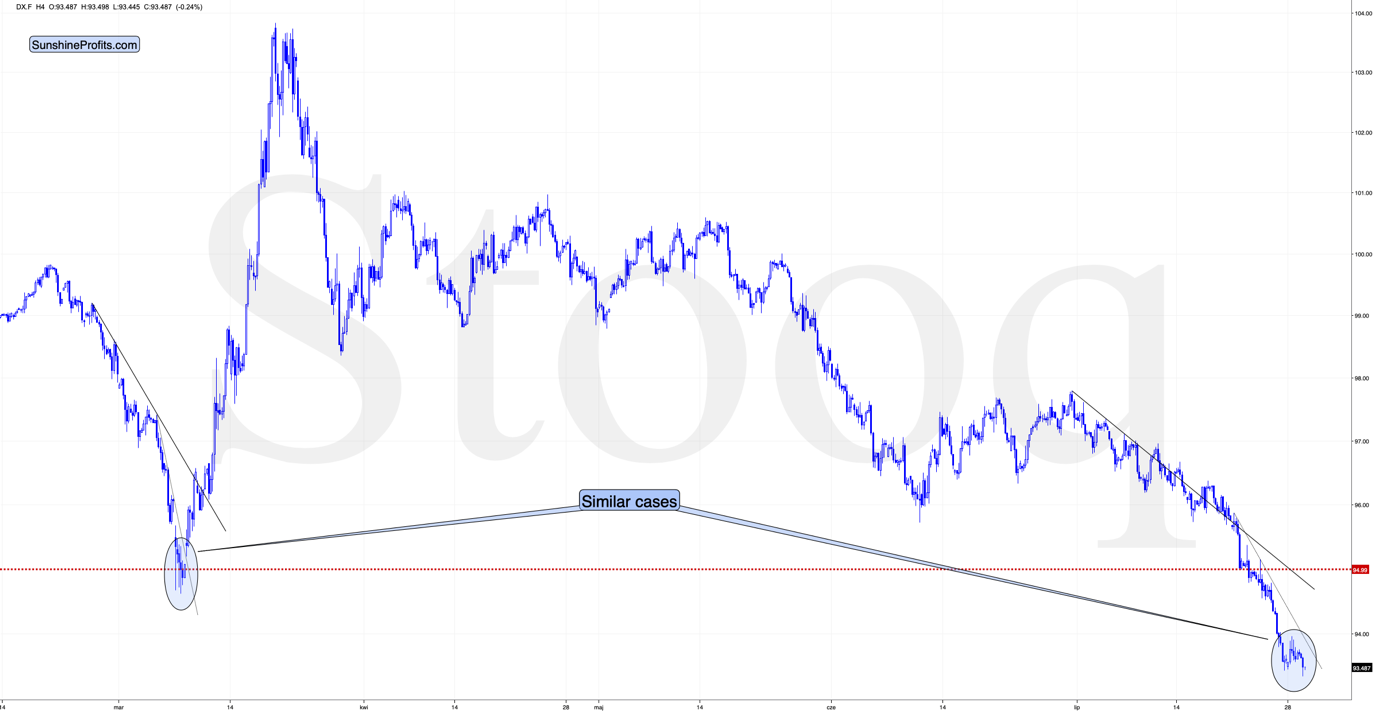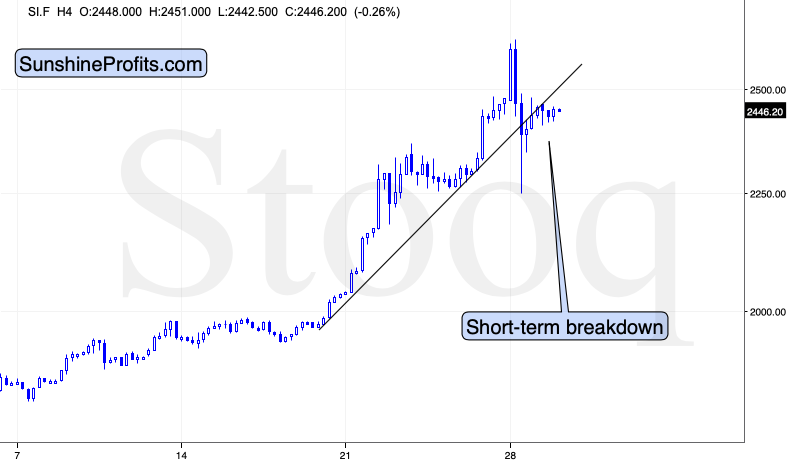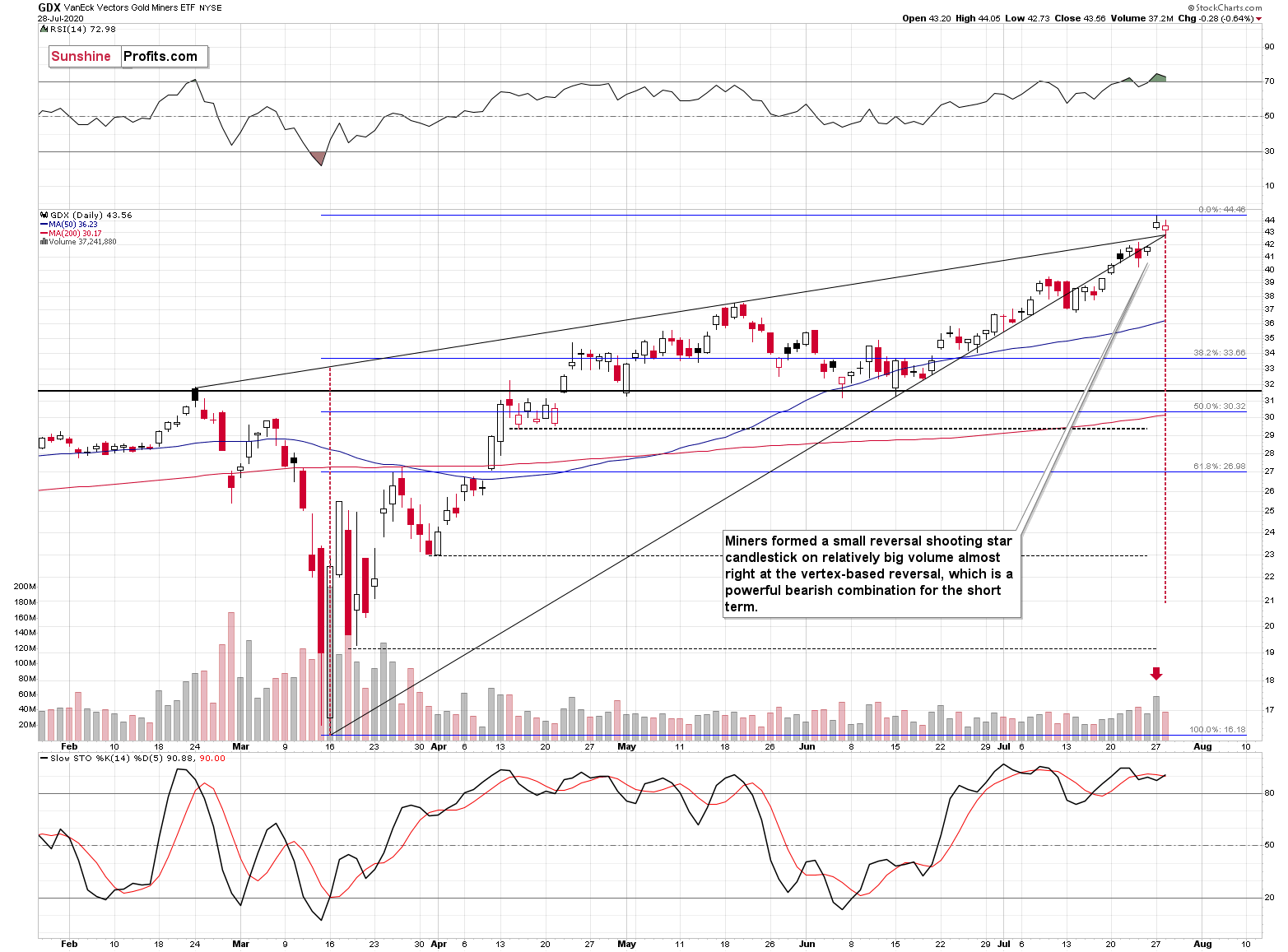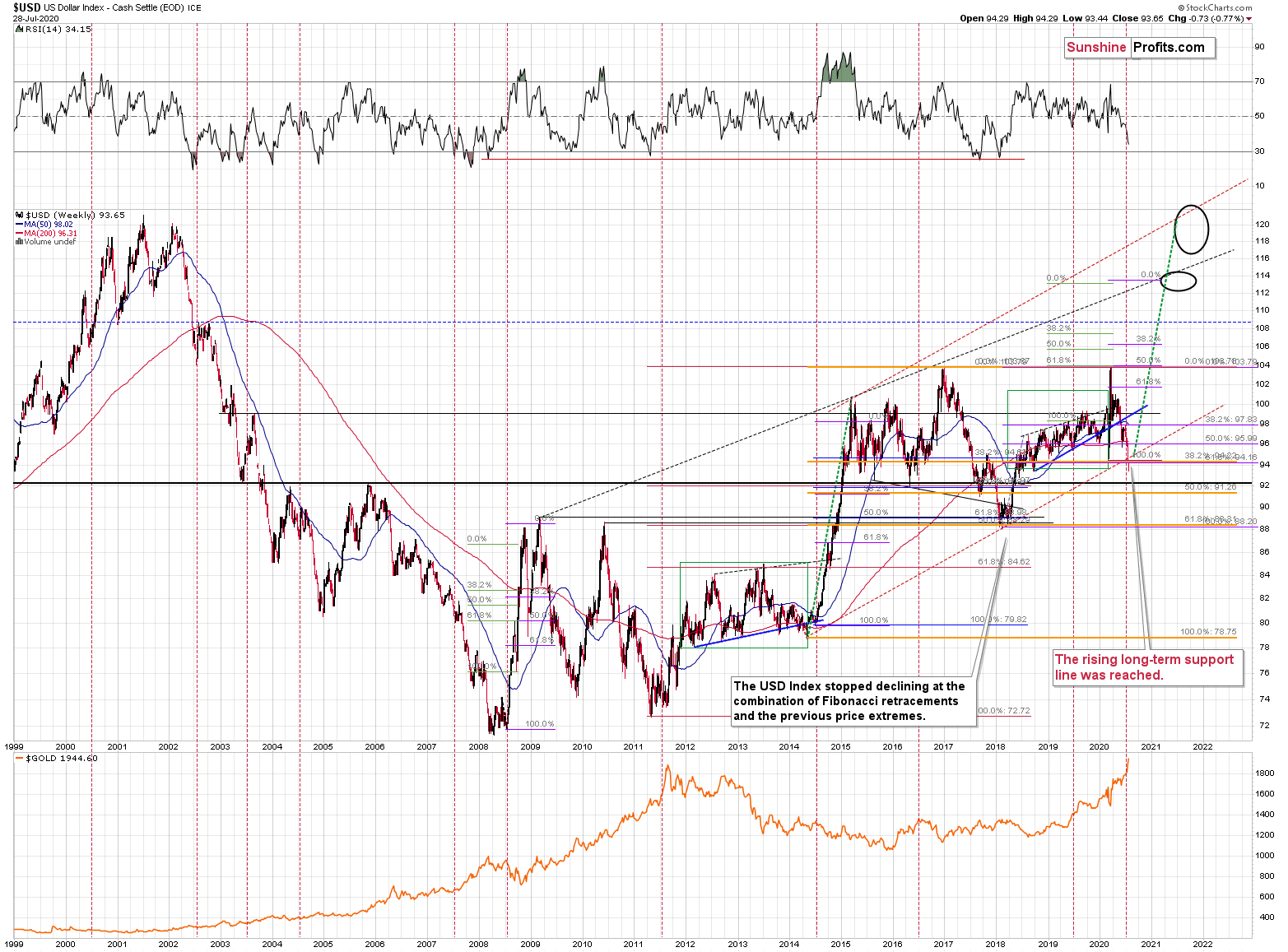Briefly: in our opinion, full (300% of the regular position size) speculative short positions in mining stocks are justified from the risk/reward point of view at the moment of publishing this Alert.
We started yesterday's analysis with gold's very short-term breakdown as well as its link to what's going on in the USD Index, and we'll start today's text in the same way. The reason is simple - gold's link with the USDX continues to point to the same outcome, while gold's very short-term breakdown was verified. Let's start with the latter.
After gold's yesterday's overnight $70+ plunge, it moved back up, but it didn't manage to invalidate this breakdown. It only moved back to the previously broken line and then paused. In today's pre-market trading, it's declining once again.
And what did the USD Index do recently?
While gold didn't move back above its rising support / resistance line, let alone the previous high, the USD Index did move below its previous low.
This means that after a powerful short-term rally, gold is refusing to react to additional bullish indications. This is a strong, bearish sign. Naturally, gold's verification of its breakdown is bearish as well.
The USD Index itself is also very important, because while the move to new lows is not encouraging, it's worth keeping in mind that the early March bottom was actually a series of tiny bottoms, when the initial bottom was broken by just a little right before the USD soared.
Consequently, the loss of USD's bearish momentum might be the thing that one should focus on at the current juncture, and view the breakdown as bearish only if it is confirmed. At the moment of writing these words, the USD Index is already back above its Monday's intraday low.
Meanwhile, the breakdown in the precious metals sector doesn't end with gold. Silver seems to have verified its own breakdown.
Just like gold, silver moved back to its previous support line and verified it as resistance. It seems that both markets are waiting for USD's rally (which is likely to arrive shortly) to plunge.
Let's keep in mind that there are very strong support levels that are likely to trigger USD's rally, and we described them yesterday.
And what about the mining stocks?
In yesterday's analysis we wrote the following:
During yesterday's session, miners reversed on big volume and it happened almost right at the vertex-based reversal. It's not clear whether the reversal date was yesterday or today, so the overnight top in gold perfectly fits this technique's indication. The implications are very bearish for the short term.
Please note the "almost" in the "almost right at the vertex-based reversal". It was rather unclear whether the vertex was on Monday, or yesterday. Either way, both major technical lines crossed, which means that the price extreme has most likely formed. Since the most recent move was up, the implications are bearish. And given the recent extreme overbought signal from the Gold Miners' Bullish Percent Index, they are very bearish. As a reminder, the latter moved to the 100 level and the only previous time in the history before 2020 was before/at the 2016 top.
Before summarizing, we would like to clarify our yesterday's estimates regarding the possible decline in the GDX. Quoting from yesterday's analysis:
And speaking of profound declines, mining stocks are likely to magnify gold's decline, just like they have done it in March. Especially that the general stock market seems to have formed a short-term top - in my opinion. However, even without the latter, miners are likely to plunge if gold declines to $1,700.
At the moment of writing these words, the GLD ETF is down by 0.50% in the pre-market trading, while the GDX ETF is down by 2.71%. The GDXJ ETF is down by 3.20%. The miners are clearly providing significant leverage over the yellow metal.
The above implies a 5-6x leverage right now in case of the very short-term moves. If GLD was to decline to about $158 (which approximately corresponds to $1,700 in gold futures) from yesterday's closing price of $182.23, it would imply a decline by about 13.3%. Given the 5-6x leverage, this could result in a true carnage in the miners. 13.3% x 5 = 66.5% and 13.3% x 6 = 79.8%.
Given yesterday's closing price of the GDX ETF of $43.84, a decline of 70% of the value would imply a slide to about $13.
Will miners really slide as low?
It's possible, but they could bottom much higher, as the initial downside leverage would likely wear off, and right before gold bottoms, miners might already rally back up.
Consequently, as it is the case with silver, the point was not to tell you that GDX has to decline to $13, but to show you that it could really decline very profoundly.
I put the last two paragraphs in bold to emphasize that the above estimates were not aimed at calculating the binding exit price right now, but to show you that the downside potential is huge. Our downside target (the one in the "trading capital" part below the summary) is more conservative and it's based on the technical support levels that are closer to the current price levels. Still, we will monitor the market and if GDX and GDXJ are already much lower while gold is still at about $1,800, we might move the exit target levels lower (so that the trading positions are likely to be exited with gold close to $1,700).
Finally, before quoting our thoughts on the overview of the upcoming decline, we would like to share a reply to our previous comments, where we described the specific feedback that we read recently, and that we read in 2018. The comments were a digression that was a part of our comments on USD's long-term picture, so we'll feature it as well.
The USD Index just moved slightly below the 38.2% Fibonacci retracement level that's based on the 2014 - 2020 rally (marked with orange), and below the 61.8% Fibonacci retracement level that's based on the 2018- 2020 rally (marked with purple).
Each of these retracements is powerful on its own, but taking them both into account and then combining them with a rising long-term support line creates a very powerful support.
And this time, people are also hating on me due to me speaking out about what I see on the charts and what is my opinion about it. I can't imagine what obscenities are written about the analyst who - on Forbes.com - wrote an article entitled "Stay The Hell Away From Gold".
On a side note, the hateful comments are quite surprising. Yes, it would have been much better to become bearish only right now, and not early before the mining stocks refused to move to new highs. Yes, we were too early with the current short position in the miners (we didn't feature shorting suggestions for silver or gold, though, only price targets as they were requested by our readers). Yes, if possible, we would love to get back in time and delay opening our current trading positions. We are not 100% correct and will never be, and the same applies to everyone else in this business, which is why position sizing is so important. With the benefit of hindsight, all tops and bottoms are obvious, and nobody will pick all of them. However, at any given time, when I made an observation, comment or decision, I did so with greatest care about my subscribers and readers.
The thing that's not that intuitive is that for an analyst this "greatest care" means being as objective as possible and not automatically going with majority or with what's currently most popular, easy to write, or easy to read. In fact, an analyst, who would do that, would be completely useless, as a simple online survey asking about people's sentiment, could easily replace them.
The value that the analyst can generate comes from providing a synthesis of what they view as important, including analogies, patterns, fundamentals, cycles, and whatever they find as justified based on a reasonable methodology. Then, investors can use this information along with some other details about the market (perhaps other analysts, perhaps their own research, perhaps a certified investment adviser) or about themselves (risk tolerance, ability to take on risk, liquidity requirements and so on) to make informed investment decisions. By not speaking their mind (even against what the majority thinks), the analyst is actually refusing to do what they are supposed to do, and how they should be providing value to investors.
The analysts' responsibility is to provide their opinions as objectively, as thoroughly as possible and without worrying about "pleasing" others with their comments. That's how they can really care about people. Analysts are not responsible for each investor's gains or losses, as they are not pulling the final strings. Of course, the analyst can exercise extra care by providing hints regarding position sizing (we're linking to our complex article on that matter in each of our Gold & Silver Trading Alerts, usually more than once; plus we are providing a simple simulation of excessive and relatively normal position sizes), but it is the investor who is responsible for executing all that.
Sadly, it is sometimes the case that people use the analyses as a "scapegoat" should they need it - and they need it rather sooner than later if they use excessive position sizes. Instead of really digging into the details of a given analysis and position sizing, people sometimes use all or most of their capital for a single (perhaps even leveraged) trade, especially if a single article makes a good job explaining a given analyst's reasoning. If this trade works in their favor, they are ecstatic and ready to gain more adrenaline on their next over-leveraged trade. When a trade finally doesn't go as well as planned (it has to, as nobody is always correct), their losses are already so big that they can't recover. And then they find a scapegoat in the form of someone, whose opinion they decided to use, as if it wasn't their investment decision, but this "someone's". And the more they are really angry with themselves (and the less they are willing to accept the responsibility for their investment decisions), the more anger they will express toward others, regardless of what they've done previously for them or in general (like very few people remember that we made money on the March decline and then we made money on the rebound buying precisely on March 13).
This is all very much connected with the overall concept of ego and ownership that a former Navy Seal leader Jocko Willink is discussing in his book called "Extreme Ownership". That's one of the best books that I read, definitely worth your time, but watching him speak about it on YouTube would also be a good idea if you're short on time (who isn't?).
I think that I already diverted from the regular analysis too much, so I will be getting back on track, but I would like to say that again regarding the responsibility:
The analysts' responsibility is to provide their opinions as objectively, as thoroughly as possible and without worrying about "pleasing" others with their comments. That's how they can really care about people. Analysts are not responsible for each investor's gains or losses, as they are not pulling the final strings. Investors/traders are responsible for their gains and losses, and for making sure they get enough details before making their investment decisions. I - and everyone at Sunshine Profits - strive to help you as much as I can, but these will be your profits, and your responsibility if you make them (or not).
Analysts will be right, and analysts will be wrong. No exceptions. We disagree with Mr. Larry Light, who suggests one to "stay the hell away from gold", as we think that gold is a great buy long term, but it still needs to correct profoundly before soaring. However, we realize that Mr. Light might be right here or in many other ways, and while we disagree with him, we disagree respectfully.
We also disagree with those, who say that gold will soar indefinitely without bigger corrections, especially now, shortly after the Gold Miners Bullish Percent Index flashed the extreme oversold signal. And once again - we disagree respectfully.
Here's the reply that we received from one of our subscribers (I obtained author's permission to share it):
"I would like to comment on the Gold and Silver Alert dated 27th July 2020 [the ones quoted above] and the harsh comments received.
I have seen examples of this emotion on many occasions. I am a Kiwi and as most kiwis a rugby player. Our national side the All Blacks are the most successful sporting franchise the world has seen with a win rate of 76%. WHY. Because the platform they stand on is as deep as it is wide. The knowledge and experience which is the platform has been formed over a long period of time by past players taking up positions and replenishing the knowledge base in the form of coaches, managers, Presidents etc etc therefore always evolving and striving for excellence.
When the All Blacks lose the comments are very harsh from the international community and from local supporters. They are emotionally upset because of the loss (our own people) which leads to comments such as the coach should be changed, the selectors picked the wrong side or the players were too complacent and they played the wrong tactics etc. These comments are then repeated by the team that beat All Blacks.
My point here is that with a 76% winning rate (which equates to a very strong knowledge platform) comments made should take this into account.
The foundation that SUNSHINE PROFITS sits on is about education, knowledge and experience from well qualified people and with a win rate of 70% + very similar to the ALL BLACKS.
Personally I have found another All Black team in Sunshine profits."
There were winning trades and there were losing trades. There were good long-term investment decisions, and there were bad long-term investment decisions. And this will always be the case with everyone in this business. Obviously, it would have been ideal to get back with the long-term investment capital in late 2015 or early 2016 (and I would give a lot to get back in time and help people position themselves at that time, as the care about people's capital has always been the core motivation of my actions), but since the precious metals market is likely to sell off significantly in the not-too-distant future, the jury is still out on whether waiting to re-enter the long-term investment positions (having exited them years ago, in 2013) in gold, silver, and mining stocks was a good idea. What I think is optimal right now, is to enter the long-term investment positions after this upcoming significant, but perhaps short-lived decline - but, as always, we can't promise that this major sell-off will indeed materialize.
While there is a part of the investment community that will focus on what could have been done better, there are also many people, who focus on the bigger picture and appreciate what we do, and we are very grateful for these comments.
Overview of the Upcoming Decline
As far as the current overview of the upcoming decline is concerned, I think that after bottoming temporarily at about $1,700, gold, silver and miners will bounce back - perhaps $30-$50 or so in gold, and then we will probably see another move lower, with silver declining more than miners. That would be in tune with how the markets initially reacted to the Covid-19 threat.
At this time it seems that after the initial decline to $1,700, gold could correct and then decline to $1,500 - $1,600 and that would be the final bottom - one that would hold for years, perhaps decades.
Still, it's possible that the $1,700 bottom in gold would be the final bottom.
How will we tell, which scenario is more likely - a decline visibly below $1,700 or just to it? Based on the way different parts of the precious metals sector react to the decline and to the initial rebound. If silver catches up with the decline when gold moves to $1,700, but miners lead on the way back up (strongly so), it will be more likely that the bullish scenario prevails. If we see the opposite - miners are weak during the rebound and silver doesn't catch up with the decline once gold approaches $1,700, the bearish case will prevail. Anything in between will require additional confirmations and we will keep you - our subscribers - updated in any case.
The impact of all the new rounds of money printing in the U.S. and Europe on the precious metals prices is very positive in the long run, but it doesn't make the short-term decline unlikely. In the very near term, markets can and do get ahead of themselves and then need to decline - sometimes very profoundly - before continuing their upward march.
Summary
Summing up, it seems that gold has formed its final top in yesterday's overnight trading, just as the USD Index seems to have finally bottomed today. Gold and silver have both reacted very strongly to the USDX developments, which has very bearish implications for the following days. The verifications of the very short-term breakdowns in gold and silver serve as bearish confirmations.
The miners have reversed this week on strong volume and practically right at the vertex-based reversal, and it all happened after they had flashed the extremely overbought signal through the Gold Miners Bullish Percent Index.
Naturally, everyone's trading is their responsibility, but in our opinion, if there ever was a time to either enter a short position in the miners or to increase its size if it wasn't already sizable, it's now. We made money on the March decline and on the March rebound, and it seems that another massive slide is about to start. When everyone is on one side of the boat, it's a good idea to be on the other side, and the Gold Miners Bullish Percent Index literally indicates that this is the case with mining stocks.
After the sell-off (that takes gold below $1,600), we expect the precious metals to rally significantly. The final decline might take as little as 1-6 weeks, so it's important to stay alert to any changes. Especially that if gold repeats its 2011 performance, the very initial bottom could form as early as this week.
Today is the FOMC day, which might serve the trigger for market's moves. At this time, the market forces appear ready to make gold slide and USDX rally, so perhaps it will be the FOMC that provides the trigger to which the markets would react. Also, please note that the FOMC could trigger some volatility right before and right after it.
Most importantly - stay healthy and safe. We made a lot of money on the March decline and the subsequent rebound (its initial part) price moves (and we'll likely make much more in the following weeks and months), but you have to be healthy to really enjoy the results.
As always, we'll keep you - our subscribers - informed.
To summarize:
Trading capital (supplementary part of the portfolio; our opinion): Full speculative short positions (300% of the full position) in mining stocks is justified from the risk to reward point of view with the following binding exit profit-take price levels:
Senior mining stocks (price levels for the GDX ETF): binding profit-take exit price: $32.02; stop-loss: none (the volatility is too big to justify a SL order in case of this particular trade); binding profit-take level for the DUST ETF: $28.73; stop-loss for the DUST ETF: none (the volatility is too big to justify a SL order in case of this particular trade)
Junior mining stocks (price levels for the GDXJ ETF): binding profit-take exit price: $42.72; stop-loss: none (the volatility is too big to justify a SL order in case of this particular trade); binding profit-take level for the JDST ETF: $21.22; stop-loss for the JDST ETF: none (the volatility is too big to justify a SL order in case of this particular trade)
For-your-information targets (our opinion; we continue to think that mining stocks are the preferred way of taking advantage of the upcoming price move, but if for whatever reason one wants / has to use silver or gold for this trade, we are providing the details anyway. In our view, silver has greater potential than gold does):
Silver futures downside profit-take exit price: unclear at this time - initially, it might be a good idea to exit, when gold moves to $1,703.
Gold futures downside profit-take exit price: $1,703
Long-term capital (core part of the portfolio; our opinion): No positions (in other words: cash
Insurance capital (core part of the portfolio; our opinion): Full position
Whether you already subscribed or not, we encourage you to find out how to make the most of our alerts and read our replies to the most common alert-and-gold-trading-related-questions.
Please note that the in the trading section we describe the situation for the day that the alert is posted. In other words, it we are writing about a speculative position, it means that it is up-to-date on the day it was posted. We are also featuring the initial target prices, so that you can decide whether keeping a position on a given day is something that is in tune with your approach (some moves are too small for medium-term traders and some might appear too big for day-traders).
Plus, you might want to read why our stop-loss orders are usually relatively far from the current price.
Please note that a full position doesn't mean using all of the capital for a given trade. You will find details on our thoughts on gold portfolio structuring in the Key Insights section on our website.
As a reminder - "initial target price" means exactly that - an "initial" one, it's not a price level at which we suggest closing positions. If this becomes the case (like it did in the previous trade) we will refer to these levels as levels of exit orders (exactly as we've done previously). Stop-loss levels, however, are naturally not "initial", but something that, in our opinion, might be entered as an order.
Since it is impossible to synchronize target prices and stop-loss levels for all the ETFs and ETNs with the main markets that we provide these levels for (gold, silver and mining stocks - the GDX ETF), the stop-loss levels and target prices for other ETNs and ETF (among other: UGLD, DGLD, USLV, DSLV, NUGT, DUST, JNUG, JDST) are provided as supplementary, and not as "final". This means that if a stop-loss or a target level is reached for any of the "additional instruments" (DGLD for instance), but not for the "main instrument" (gold in this case), we will view positions in both gold and DGLD as still open and the stop-loss for DGLD would have to be moved lower. On the other hand, if gold moves to a stop-loss level but DGLD doesn't, then we will view both positions (in gold and DGLD) as closed. In other words, since it's not possible to be 100% certain that each related instrument moves to a given level when the underlying instrument does, we can't provide levels that would be binding. The levels that we do provide are our best estimate of the levels that will correspond to the levels in the underlying assets, but it will be the underlying assets that one will need to focus on regarding the signs pointing to closing a given position or keeping it open. We might adjust the levels in the "additional instruments" without adjusting the levels in the "main instruments", which will simply mean that we have improved our estimation of these levels, not that we changed our outlook on the markets. We are already working on a tool that would update these levels on a daily basis for the most popular ETFs, ETNs and individual mining stocks.
Our preferred ways to invest in and to trade gold along with the reasoning can be found in the how to buy gold section. Additionally, our preferred ETFs and ETNs can be found in our Gold & Silver ETF Ranking.
As a reminder, Gold & Silver Trading Alerts are posted before or on each trading day (we usually post them before the opening bell, but we don't promise doing that each day). If there's anything urgent, we will send you an additional small alert before posting the main one.
Thank you.
Sincerely,
Przemyslaw Radomski, CFA
Editor-in-chief, Gold & Silver Fund Manager


